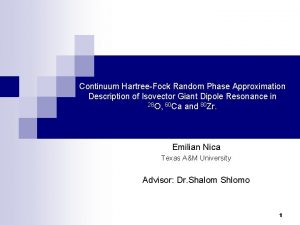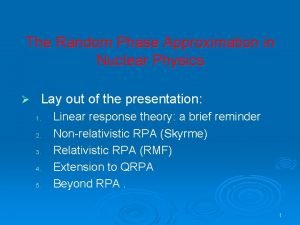Chapter 34 THE MULTICOMPONENT RANDOM PHASE APPROXIMATION 34








- Slides: 8

Chapter 34 – THE MULTI-COMPONENT RANDOM PHASE APPROXIMATION 34: 2. INCOMPRESSIBLE POLYMER MIXTURE 34: 3. THE SINGLE-CHAIN FORM FACTORS 34: 4. BINARY HOMOPOLYMER BLEND MIXTURE 34: 5. TERNARY HOMOPOLYMER BLEND MIXTURE 34: 7. THE DIBLOCK COPOLYMER CASE

34: 2. INCOMPRESSIBLE POLYMER MIXTURE Scattering cross section: Matrix notation: Non-interacting system scattering factors: Excluded volume terms: Scattering length densities: 2 3 1 2 1 3

MORE ON THIS Incompressibility condition: This implies: Spinodal condition:

34: 3. THE SINGLE-CHAIN FORM FACTORS “Bare” homopolymer scattering factor: “Bare” copopolymer scattering factor: Homopolymer form factor: 1 4 2 Complex architectures: 3 10 0 5 6 7 12 0 8 11 0 9

34: 4. BINARY HOMOPOLYMER BLEND MIXTURE Bare scattering factor for component 1: Excluded volume factor for component 1: Fully interacting system scattering factor: Scattering cross section: This is referred to as the de Gennes formula

34: 5. TERNARY HOMOPOLYMER BLEND MIXTURE Bare scattering factors: Excluded volume factors: Scattering cross section:

34: 7. THE DIBLOCK COPOLYMER CASE Homopolymer blend mixture Fully interacting system scattering factor: Scattering cross section: Diblock copolymer

COMMENTS -- The Random Phase Approximation (RPA) model applies to homogeneous (single-phase) polymer mixtures. -- It does not apply to the demixed phase (phase separated) region. -- It can handle homopolymers and other architectures (copolymers, comb polymers, star polymers, etc). -- It can predict the scattering cross section as well as the spinodal temperature. -- It can work for Lower Critical Spinodal Temperature (LCST) and Upper CST blend mixtures.
 Random assignment vs random sampling
Random assignment vs random sampling Random assignment vs random selection
Random assignment vs random selection Normal phase vs reverse phase chromatography
Normal phase vs reverse phase chromatography Hplc reverse phase vs normal phase
Hplc reverse phase vs normal phase Mobile phase and stationary phase
Mobile phase and stationary phase Mobile phase vs stationary phase
Mobile phase vs stationary phase Normal phase vs reverse phase chromatography
Normal phase vs reverse phase chromatography Line current and phase current
Line current and phase current Which detector used in hplc
Which detector used in hplc















